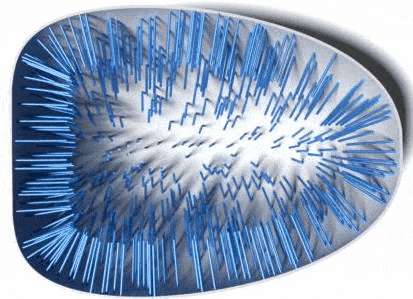
Investigators at Northwestern Medicine, the Flatiron Institute, and Princeton University have characterized how developing egg cells move and reorganize their cytoplasm as part of their growth, according to a study published in Nature Physics, a discovery which furthers the field’s understanding of the basic cellular processes involved in the earliest stages of development.
In cells, cargo is carried along tiny “highways,” known as microtubules, by the molecular motor proteins dynein and kinesin. These small pathways sit amid cytoplasm, a gel-like substance filled with various organelles and supported by a cytoskeleton, which helps give the cell its shape. While cytoplasm can appear to be formless, its structure is highly organized within the cell.
In oocytes, a kind of primordial egg cell, cytoplasm is known to undergo spontaneous reorganization as the cell develops, which moves organelles to appropriate locations within the cell as it grows. Exactly how the cytoplasm moves has remained poorly understood, according to Vladimir Gelfand, PhD, the Leslie B. Arey Professor of Cell, Molecular, and Anatomical Sciences and a co-author of the study.
In the current study, investigators observed cytoplasmic flow in oocytes from fruit flies using light microscopy. They found that the microtubules act like tiny flexible fibers inside the cytoplasm and join together to create vortices, or tiny tornadoes, which force the cytoplasm to move inside the cell, thus re-arranging organelles as well as transporting molecules as the cell grows.

Using the data from their observations, scientists at the Flatiron Institute then developed a 3D model of the cytoplasmic flow.
“There are multiple of these microtubules forced by the molecular motors and they hydrodynamically interact with each other,” said Sayantan Dutta, PhD, a visiting scientist at Feinberg and former student at Princeton and the Flatiron Institute’s Center of Computational Biology, who was first author of the study. “Due to the hydrodynamic interaction, the microtubules bend in a coordinated fashion to create a large-scale flow. That’s our main discovery that is supported both by extensive computer simulations and also by the supplemental imaging.”
The findings represent a step forward in understanding the most basic cellular processes that growing egg cells undergo as part of their development, Gelfand said.
“These cells start with lots of small local twisters and those twisters compete with each other,” said Gelfand, who is also a professor of Cell and Developmental Biology. “And the strongest one wins; they all fuse into one big twister that moves the cytoplasm around. What we have done is a calculation of how that actually happens in real life.”
Moving forward, Gelfand will continue to collaborate with the Flatiron Institute to model how oocytes interact with attached “sister” cells to organize cytoplasmic movement in the context of developing embryos.
“This is just the beginning of our collaboration with Flatiron Institute because they have modeled the very first example of motility in the cytoplasm of oocytes,” said Gelfand, who is a member of the Robert H. Lurie Comprehensive Cancer Center of Northwestern University.
The study was supported by National Institutes of Health grants R01GM134204 and R35GM131752 and National Science Foundation grant DMR-2004469.






